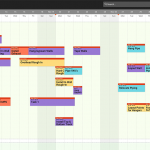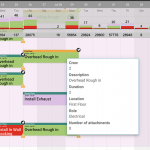Getting to the end of a project only to tackle hundreds of punch-list items is anything but satisfying. Punch lists, or lists of work that needs to be redone, typically result from some kind of process failure during the project. Generally, a punch list item is work that wasn’t done correctly the first time, or that was damaged by other work that was done afterwards to the extent that it doesn’t meet standards.
While most people accept punch lists as a necessary evil, they’re more avoidable than you might think. Read on for four tips from Lean construction expert Hal Macomber on how to run your projects in a post-rework world.
1. Define Acceptance Criteria Early
Make it a practice to establish a benchmark for each task the first time it’s performed. A benchmark is set by having each type of work inspected the first time it’s done to ensure that it’s acceptable to the architect before the work continues. The benchmark then serves as a visual standard for the team to reference going forward. “It depends on the project, but if you have eighty-four rooms and you benchmark the first one, you can avoid all the mistakes you made on the first one in the eighty-three additional units. So it’s possible that you could build eighty-three units without rework associated with standard,” says Macomber.
2. Foster a “Customer Mindset”
If you can get your teams to view on another as customers, the entire mindset of the project changes. When people see the next trade in line as their customer—rather than the eventual occupant of the building—the need to optimize the use of the space becomes more immediate, as does the obligation to protect one another’s work. “Get people to treat each other’s work with respect, treat each other as customers and ensure that you are not going to make work for other people, just like you don’t want other people to make work for you,” advises Macomber.
3. Look for Patterns
One way to preemptively minimize punch list items is to look for systemic patterns that may be causing issues on your project. Macomber offers an example: “If a procurement was held up because a submittal took too long to get approved by the architect, engineer and owner, the likelihood that the next submittal that goes through the process will also be late could be very high.” Noticing problematic patterns and addressing them early on at the system level will greatly minimize your punch list.
4. Address Punch List Items Daily
Along the same lines, punching your list (figuratively speaking) early and often is important. By waiting until an entire floor is finished, for example, you increase the likelihood of having to do the same type of rework multiple times. “If someone took a shortcut, they probably didn’t take it once. They probably took it as many times as they had to do that task,” says Macomber. Set a benchmark as early as possible to avoid having to fix the same mistake multiple times later on.
Macomber recommends daily punch lists for maximum efficiency. “Often people think that a zero-punch-list project means that you punch as you go so that when you get to the certificate of occupancy, you’re done. But that’s not what we mean by zero-punch-list project. We mean you didn’t have anything to punch in the first place.”










